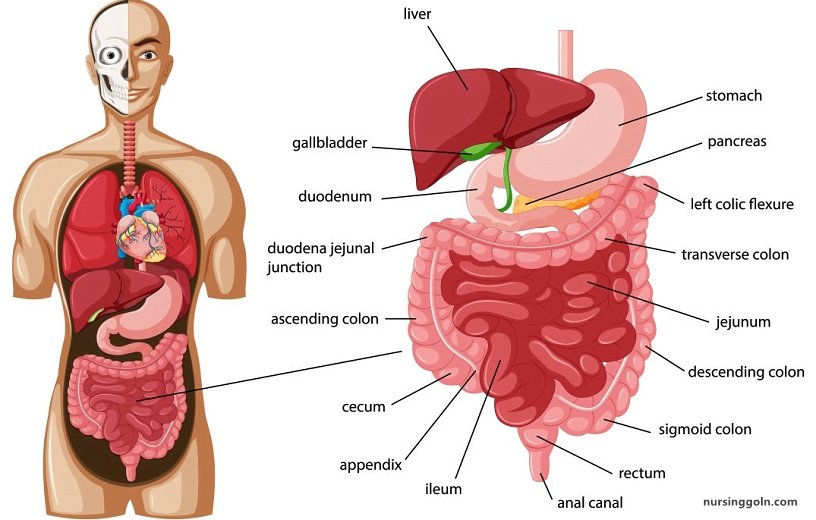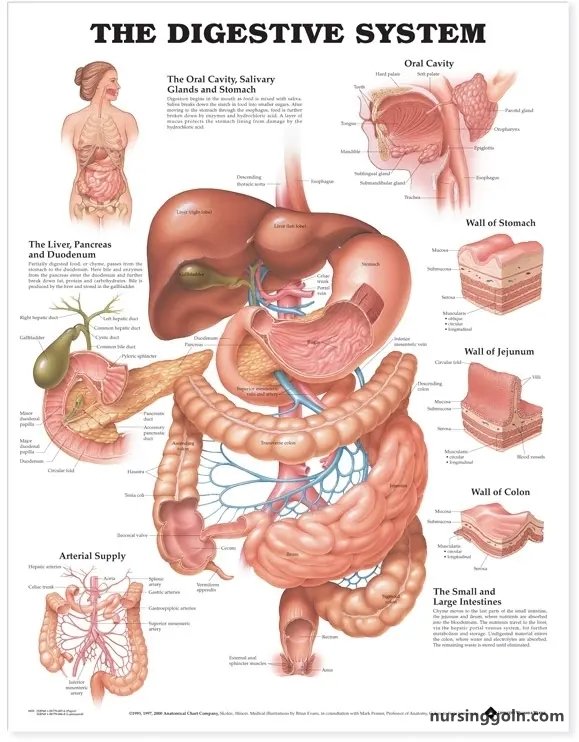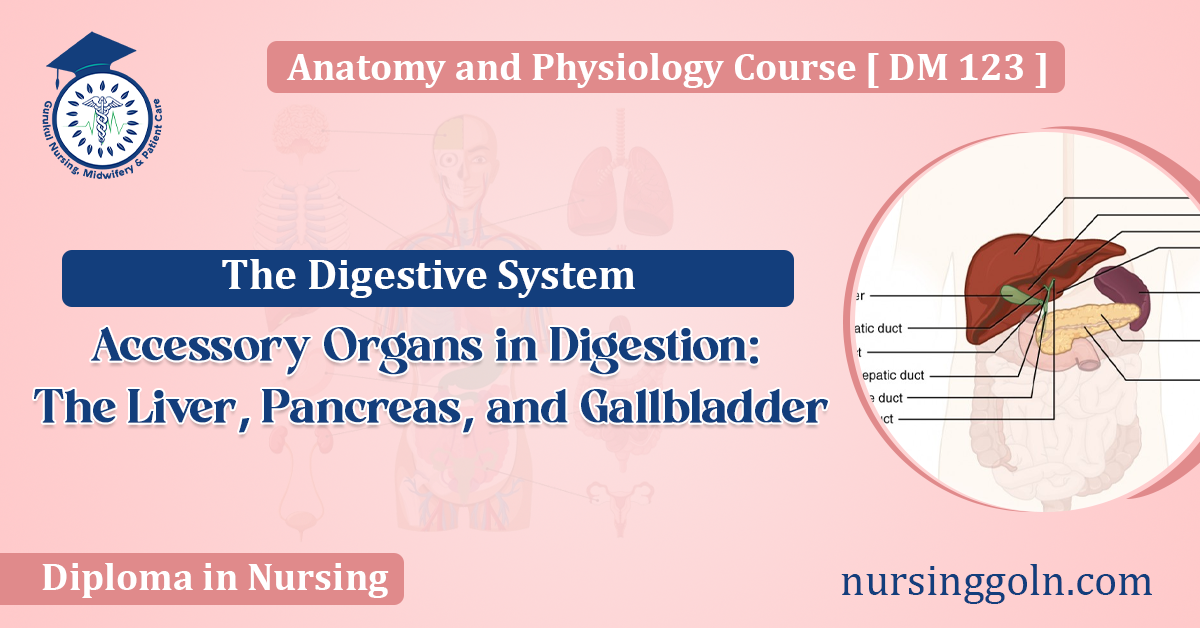Today our topic of discussion is ” Accessory Organs in Digestion: The Liver, Pancreas, and Gallbladder “. The digestive system is a complex and finely tuned orchestration of organs, tissues, and enzymes working together to break down and absorb the nutrients from the food we consume.
While the stomach and intestines play pivotal roles, there are several accessory organs that contribute significantly to the process of digestion. Among these, the liver, pancreas, and gallbladder are instrumental in ensuring that our bodies receive the essential nutrients they need to function optimally. In this comprehensive article, we will explore the anatomy, functions, and intricate processes that occur within these crucial digestive accessory organs.
Accessory Organs in Digestion: The Liver, Pancreas, and Gallbladder: The Digestive System

1. The Liver: The Metabolic Powerhouse
The liver is the largest internal organ in the human body and serves as a metabolic powerhouse with a wide range of vital functions. It is located in the upper right abdomen, just beneath the diaphragm.
Anatomy of the Liver
The liver is divided into two primary lobes:
- Right Lobe: The larger of the two lobes, it is positioned on the right side of the body.
- Left Lobe: The smaller of the two lobes, it is situated on the left side of the body.
2. Functions of the Liver
The liver is a multi-faceted organ, performing numerous functions that are essential for overall health:
a. Metabolism
- Carbohydrate Metabolism: The liver plays a central role in regulating blood sugar levels. It stores glucose in the form of glycogen and can break it down into glucose when needed.
- Lipid Metabolism: The liver is responsible for the production of cholesterol and triglycerides, essential for various bodily functions.
- Protein Metabolism: It synthesizes proteins, including blood-clotting factors and albumin, which helps maintain blood volume and pressure.
b. Detoxification
- Removal of Toxins: The liver filters and detoxifies harmful substances, such as drugs and alcohol, from the bloodstream.
c. Bile Production
The liver produces bile, a greenish fluid that is stored in the gallbladder. Bile plays a crucial role in digestion, particularly in the breakdown and absorption of fats.
d. Nutrient Storage
The liver stores essential nutrients, including vitamins and minerals, which can be released into the bloodstream as needed.
e. Immune Function
The liver is involved in immune function and helps protect the body from infections and diseases.
f. Blood Filtration
The liver filters the blood, removing damaged red blood cells and foreign particles.
g. Regulation of Blood Clotting
The liver synthesizes clotting factors and is essential for the process of blood clotting to prevent excessive bleeding.

3. The Pancreas: A Dual-Purpose Gland
The pancreas is a dual-purpose gland, with both endocrine and exocrine functions. It is located behind the stomach and plays a critical role in digestion and glucose regulation.
Anatomy of the Pancreas
The pancreas can be divided into three main regions:
- Head: The head of the pancreas is located near the duodenum, where it releases pancreatic secretions into the small intestine.
- Body: The body of the pancreas extends horizontally behind the stomach.
- Tail: The tail of the pancreas is the narrow end that tapers to the left.

4. Functions of the Pancreas
The pancreas has two primary functions: endocrine and exocrine.
a. Endocrine Function
The endocrine function of the pancreas involves the release of hormones directly into the bloodstream to regulate blood sugar levels. The pancreas contains clusters of cells known as the islets of Langerhans, which secrete hormones, including:
- Insulin: Insulin is responsible for lowering blood sugar levels by promoting the uptake and storage of glucose in cells.
- Glucagon: Glucagon raises blood sugar levels by stimulating the liver to release stored glucose into the bloodstream.
b. Exocrine Function
The exocrine function of the pancreas involves the production and secretion of digestive enzymes into the small intestine to aid in digestion. These enzymes include:
- Amylase: For the digestion of carbohydrates.
- Lipase: For the digestion of fats.
- Proteases: For the digestion of proteins.
These digestive enzymes are released into the duodenum, where they mix with chyme, the partially digested food from the stomach, to break down macronutrients further.

5. The Gallbladder: A Reservoir of Bile
The gallbladder is a small, pear-shaped organ that is located beneath the liver. Its primary function is to store and concentrate bile produced by the liver.
Anatomy of the Gallbladder
The gallbladder consists of several parts:
- Fundus: The rounded, bulbous end of the gallbladder.
- Body: The main, elongated portion.
- Neck: The narrow section that connects to the cystic duct.

6. Functions of the Gallbladder
The gallbladder’s primary function is to store and concentrate bile produced by the liver. When food enters the small intestine, particularly when it contains fats, the gallbladder contracts and releases bile into the duodenum. Bile plays a crucial role in the digestion and absorption of fats:
- Emulsification of Fats: Bile emulsifies fats, breaking them into smaller droplets. This process increases the surface area of fats, making them more accessible to digestive enzymes for efficient digestion.
7. The Role of Bile in Digestion
Bile is a critical component in fat digestion and absorption. Here’s how it works:
- Emulsification: Bile salts in bile interact with fats, breaking them into smaller droplets, increasing their surface area and making them easier to digest.
- Aiding in Digestion: Bile helps digestive enzymes, such as lipase, access and digest fats more efficiently.
- Micelle Formation: Bile salts surround digested fat molecules to form micelles, which transport fats to the surface of the enterocytes (lining cells of the small intestine) for absorption.
- Transport of Fat-Soluble Vitamins: Bile helps absorb fat-soluble vitamins (A, D, E, and K) by allowing them to be transported along with fats.

8. Regulation of Bile Release
Bile release is regulated by several factors:
- Presence of Fat: The primary stimulus for gallbladder contraction and bile release is the presence of fat in the duodenum. When fats are detected, the gallbladder contracts to release concentrated bile.
- Cholecystokinin (CCK): CCK is a hormone released by the small intestine in response to the presence of fats. It stimulates the gallbladder to contract and release bile.
9. Disorders and Conditions of the Liver, Pancreas, and Gallbladder
The liver, pancreas, and gallbladder can be affected by various disorders and conditions that can disrupt their functioning:
- Liver Disorders: Conditions like fatty liver disease, hepatitis, cirrhosis, and liver cancer can impair the liver’s functions.
- Pancreatic Disorders: Pancreatic disorders include pancreatitis, pancreatic cancer, and cystic fibrosis, which can affect the pancreas’s endocrine and exocrine functions.
- Gallbladder Disorders: Gallbladder disorders include gallstones, cholecystitis (inflammation of the gallbladder), and biliary colic.

10. Maintaining the Health of Digestive Accessory Organs
Maintaining the health of the liver, pancreas, and gallbladder is essential for overall well-being. Several practices can help support the health of these organs:
- Balanced Diet: Consuming a diet rich in fruits, vegetables, lean proteins, and healthy fats can support liver, pancreas, and gallbladder health.
- Moderate Alcohol Consumption: Limiting alcohol intake can reduce the risk of liver damage.
- Regular Exercise: Physical activity can help maintain a healthy weight and support overall health.
- Adequate Hydration: Staying well-hydrated supports the functions of all digestive organs.
- Regular Medical Checkups: Routine medical checkups can help detect and manage any issues with these organs in their early stages.

The liver, pancreas, and gallbladder are integral components of the digestive system, each playing a unique and essential role in digestion and overall health. The liver’s metabolic functions, the pancreas’s dual roles in endocrine and exocrine function, and the gallbladder’s concentration and release of bile collectively ensure efficient digestion and nutrient absorption.
Understanding the anatomy and functions of these digestive accessory organs is crucial for appreciating their significance in maintaining health and well-being. As we navigate the intricacies of the digestive system, the liver, pancreas, and gallbladder emerge as unsung heroes, ensuring that the food we consume is broken down, absorbed, and utilized by the body in its quest for optimal function.
Read more:
